| Is Greek Yogurt Healthier Than Regular Yogurt? If you are comparing the sugar content in Greek yogurt to regular yogurt, you are likely not making a better choice. Greek yogurt has really gained in popularity in the past few years. What makes Greek yogurt, Greek yogurt, is that it has been strained to remove some of the whey and lactose, the milk sugar, and when this happens, the end product contains slightly more protein and slightly less naturally present milk sugar. Many are touting this as the healthier option – so, is it? Yogurt IS a healthy food, IF you choose full fat, organic and plain. Since most people don’t eat plain yogurt, many people are choosing Greek over regular cow yogurt, thinking that they are consuming less added sugars, when in reality, they are not. I am going to compare Greek yogurt and regular yogurt and explain how to correctly read the label as it pertains to sugar. Yes, organic matters, but sugar is really the important component here that we want to address, because the Greek Yogurt and regular cow yogurt are not an apples to apples comparison, when it comes to sugar. Calculating sugar from a label can be tricky because the government doesn’t require labels to differentiate between added sugars and naturally occurring sugars. So, how do you make the right choice when it comes to yogurt? Let’s start with the Greek yogurt. Greek yogurt has 9 grams of sugar per 8 oz that are naturally present. This is lactose, the sugar found in milk. This is naturally present sugar and not added sugar. So, when you look at the label of Greek yogurt, you now know that 9 grams of sugar is naturally present, per 8 oz serving. For our example today, let’s look at two Greek yogurts: Chobani and Oikos 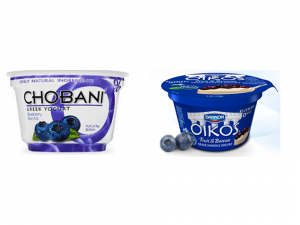
Both of these yogurts are low fat and they are both berry flavor, to make a good comparison. The Chobani yogurt has 15 grams of sugar listed on the label per the container size of 5.3 oz. I know that there are 9 grams of sugar that are naturally present in 8 oz of Greek yogurt. So, I need to do a quick calculation to determine that there are 6 grams of sugar that are naturally present in 5.3 oz of Greek yogurt. There are 15 grams of sugar listed on the Chobani label, so I know that 6 grams are naturally present and that 9 grams of sugar are added sugars. 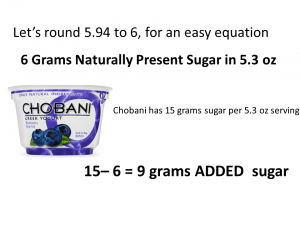
Since I know that there are 4 grams of sugar per teaspoon of sugar. I can now determine how many added teaspoons of sugar are present. I divide 9 grams by 4 = 2.25 teaspoons of added sugar in the Chobani yogurt 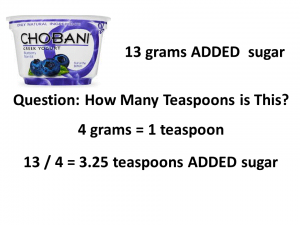
Is this insignificant? YES! If you ate one Chobani yogurt each day, you would consume 821 teaspoons of sugar, which is the equivalent of 8 1/2 pounds of sugar each year. Now let’s look at Oikos: Oikos lists 19 grams of sugar per the 5.3 oz container. From the earlier calculation, I know that there are 6 grams of sugar naturally present in 5.3 oz container of Greek yogurt, so there are 13 grams of added sugar in this Oikos yogurt, which is equivalent to 3.25 teaspoons of sugar. So there is one more teaspoon of sugar in the Oikos yogurt. 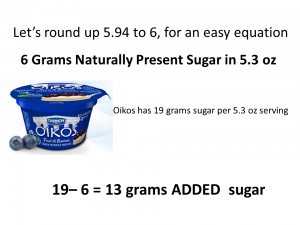
If you ate one Oikos yogurt each day, you would consume 1,186 teaspoons of sugar each year, which is the equivalent of 12 1/3 pounds of sugar each year Look at the difference just ONE teaspoon makes each day. It means that you will consume an additional 4 pounds of sugar in a year. When you are at the store comparing the sugar listed on the label of a Greek yogurt and a regular yogurt, you are not comparing apples to apples. You are comparing apples to oranges, because these two types of yogurt do not have the same amount of naturally present sugar to start with. Again, Greek yogurt has 9 grams of naturally present sugar per 8 oz serving and regular yogurt has 12 grams of sugar per 8 oz serving. Say each yogurt has 2 teaspoons of added sugars. That would mean that you would see 17 grams of sugar on an 8 oz serving of Greek yogurt and 20 grams of sugar on the label of an 8 oz serving of regular yogurt. 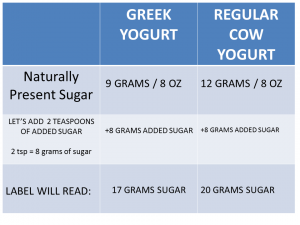
These two yogurts have the exact same amount of added sugar and yet, you would likely choose the Greek yogurt over the regular yogurt and yet, either choice would result in you consuming 7.6 pounds of added sugar in a year. 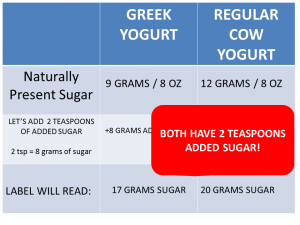
Choose plain, full fat organic Greek or regular cow yogurt. Sweeten this with berries and IF you need a little additional sweetener, try adding ½ teaspoon of honey or real maple syrup. Yes, this is still sugar, but I would rather control how much sugar I am getting on a regular basis. | 





